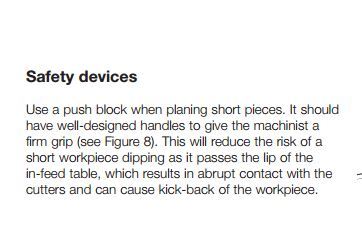I'm struggling to get to grips with my Titan planer/thicknesser in planing mode. On a rough but flat bit of wood it seems to take wood off the beginning and end but not so much the middle, leaving the wood smooth but a bit thicker in the middle.
I didn't use the push blocks as ones supplied with machine have this hard plastic bottom that has the same grip as a wet bar of soap, so was using a big bit of wood on top to guide the wood I'm planing. I had assumed maybe lack of pushblocks and lack of sufficient downward pressure was reason for uneven planing but don't know if that's right?!
I was going to ask on here where to buy good push blocks but then stumbled across threads with much arguing over whether push blocks are bad practise/dangerous or not.
Now, my head is totally effed!
I can see the value in pushsticks keeping your hands away from the cutters but how do you maintain downward pressure doing that?
How do you guys do it?
I didn't use the push blocks as ones supplied with machine have this hard plastic bottom that has the same grip as a wet bar of soap, so was using a big bit of wood on top to guide the wood I'm planing. I had assumed maybe lack of pushblocks and lack of sufficient downward pressure was reason for uneven planing but don't know if that's right?!
I was going to ask on here where to buy good push blocks but then stumbled across threads with much arguing over whether push blocks are bad practise/dangerous or not.
Now, my head is totally effed!
I can see the value in pushsticks keeping your hands away from the cutters but how do you maintain downward pressure doing that?
How do you guys do it?




































